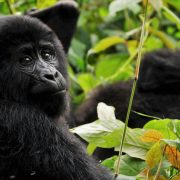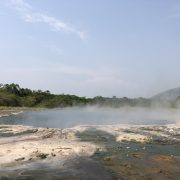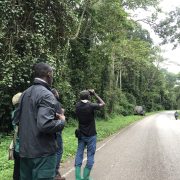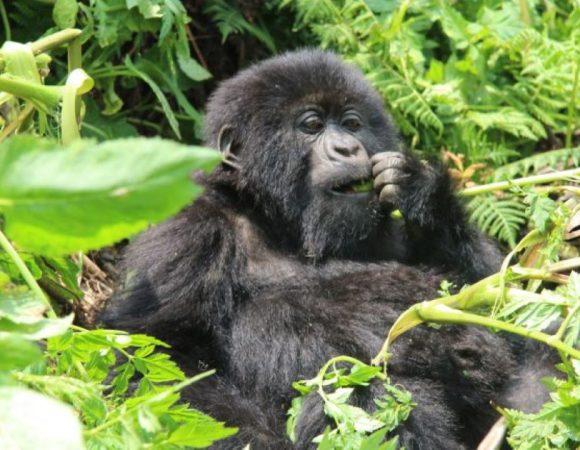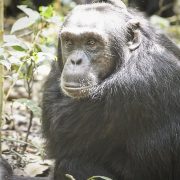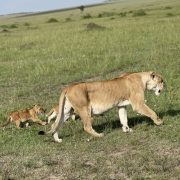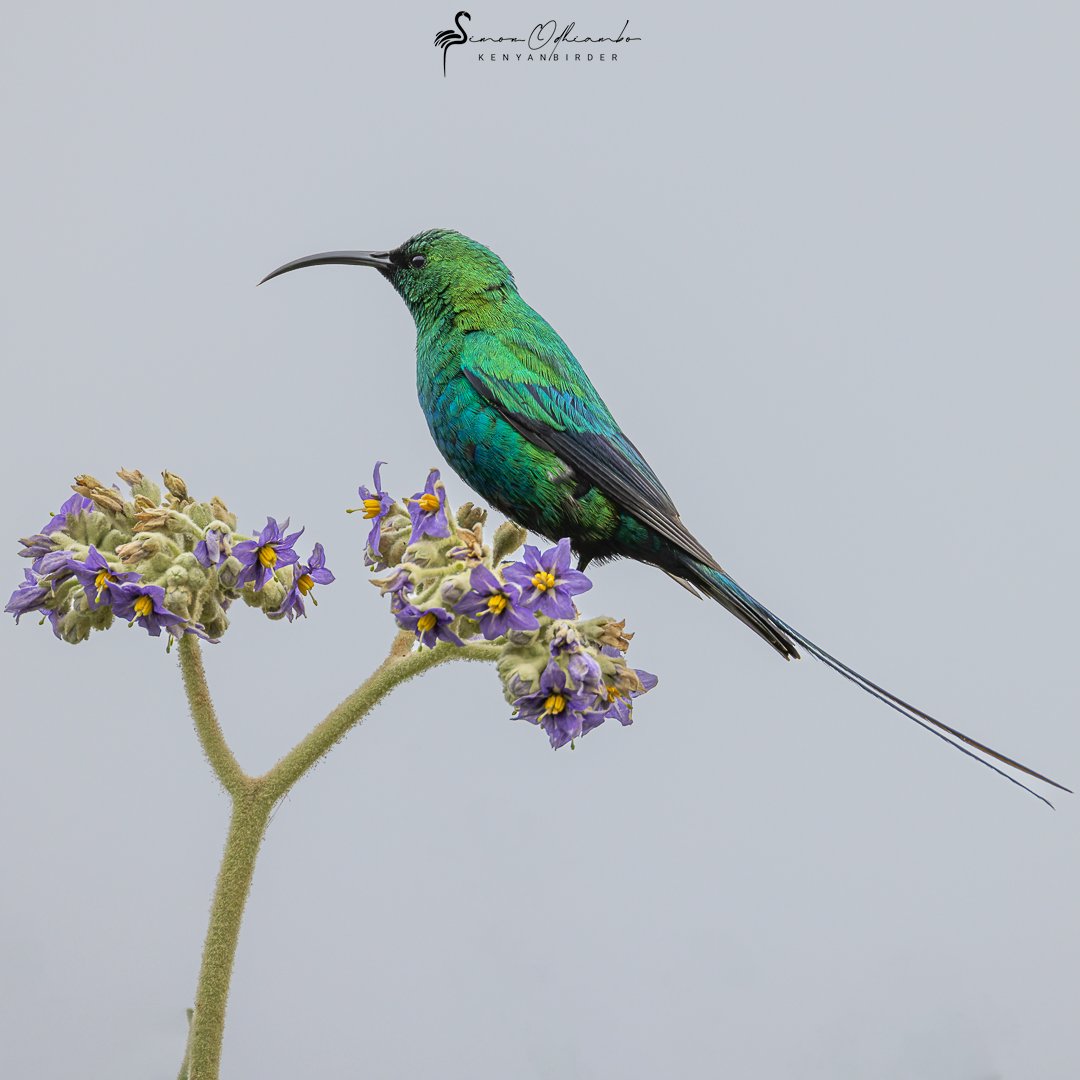
Kenya’s Avian Wonders: A 19-Day Journey Through Birding Hotspots
Birding in Kenya is a worthwhile and equally rewarding as Kenya is not only a popular birding destination but is also one of Africa’s best birding destinations. A record number of bird species can be seen in Kenya with the most sought after being the endemic species and migratory species. This 19 days birding safari in Kenya will take you on a journey exploring popular birding hot spots spread out across Kenya as you look out for endemics, near endemic species and lots of other species.
Detailed Itinerary
Day 1: Arrival and Transfer to Nairobi National Park
You start your 19 Days Safari with pick up from the Airport on arrival. At the Airport you will exchange greetings with your driver guide after which you start the journey to Nairobi National Park. Nairobi National Park is easily accessible from the Central Business District and is known as “The World’s Only Wildlife Capital”, the park is a few minutes away from Central Nairobi. As you approach the national park you will start birding along the way before finally heading to your lodge for overnight and dinner.
Meal Plan: Dinner
Journey time: 45 minutes
Accommodation Options
Luxury – Ololo Safari Lodge & Farm
Mid-range – The Emakoko
Day 2: Birding in Nairobi National Park
After an early morning breakfast at the lodge you head out for early morning birding in Nairobi National Park. It’s important to be up early so that you start to look out for the bird species as they start their day. The entire day will be spent birding – you will have the early morning birding session, then head to the lodge have lunch and then continue birding in the afternoon. You will then end the day with some evening birding to tick off more species. About 500 species of birds have been recorded at Nairobi National Park making Kenya one of the few countries in the world with a capital city that has the longest bird lists.
Birds to look out for today include Tawny Eagle, Blacksmith Lapwing, Ruppell’s Vulture, Black Kite, Long-tailed Fiscal, Red-billed Oxpeckers, Black Crake, Egyptian Goose, Yellow-billed Stork, Red-billed Teal, Wood Sandpiper, Three-banded Plover, Common Moorhen, Speckled Pigeon, Secretary Bird, Cattle Egret, African Plain Martins, Black-winged Stilt, Long-tailed Fiscal, Common Ostrich, Winding Cisticola, African Fish Eagle, Grey Crowned Cranes, Malachite Kingfisher, Winding Cisticola, Grey-capped Warbler, African Dusky Flycatcher, Madagascar Pond-heron, Lappet-faced Vulture, Greater Spotted Eagle, Kori Bustard, Martial Eagle, White-backed Vulture.etc.
Meal Plan: Breakfast, Lunch and Dinner
Day 3: Transfer to Kinangop Plateau
After having breakfast at the lodge, we start the journey to Kinangop Grasslands – an Important Bird Area (IBA) situated in Central Kenyan Highlands. Birding in Kinangop will be rewarding as we get to explore the marshes for wetland birds and the grasslands for grassland species. The landscape at Kinangop is generally flat but separated by valleys bearing streams that drain into the Karati and Malewa rivers, the plateau slopes gradually upwards to the base of the Aberdare Mountains.
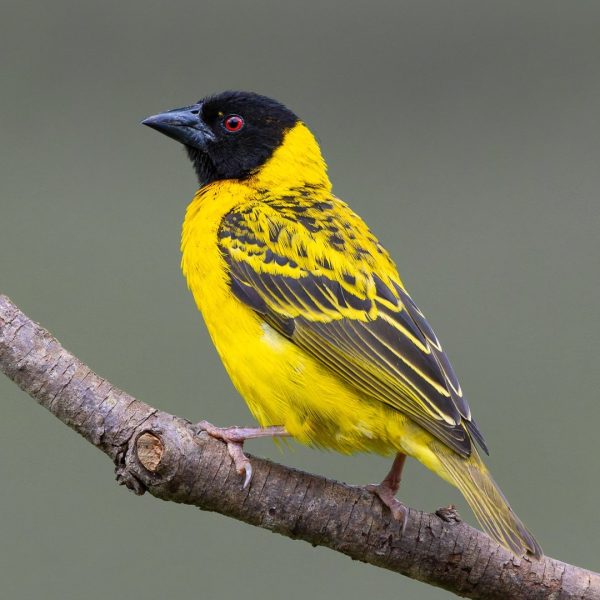
A Village Weaver. Photo credit – @Kenyanbirder
Our bird of interest on this day will be the Sharpe’s Longclaw which is endemic to Kenya. Other birds that we will look out for include Black-headed Heron, Egyptian Geese, Great Sparrow Hawk, African Spoonbills, Common Sandpiper, Black-winged Stilt, Three-banded Plover, Grey Heron, African Citril, Augur Buzzard, Kikuyu White-eye which is endemic to Kenya, Red-billed Teal, Little Grebe, Red-knobbed Coot, Hunter’s Cisticola, Kenya Rufus Sparrow, Streaky Seed eater, Bronze Sun birds, Brown Woodland warbler, African Dusky, African Stonechat, African Quail Finch, Cape Wagtail, Jackson’s Widowbird, Black-winged Kite also known as the Black-shouldered Kite, African Pitpit, Levaillant’s Cisticola, Northern Anteater-chat, Long-tailed Widowbird, Hadada Ibis, Yellow-billed Duck, Cattle Egret, Sacred Ibis, Yellow-billed Stork, African Snipe, Long-tailed Cormorant, and the Mountain Night Jar which takes one to have a keen eye in order to see it as it has great abilities to camouflage. After a long day of birding you will retire to Naivasha for overnight.
Meal Plan: Breakfast, Lunch and Dinner
Journey time: 2 hours
Mid-range: Lahai Cottages, Naivasha
Day 4: Transfer to Masai Mara as you bird along the way
After a relaxing night you continue birding to Masai Mara National Reserve, one of Kenya’s top birding destinations. Masai Mara National Reserve is an Important Bird Area (IBA) and home to over 450 species of birds including 12 species of cisticola and 54 raptors. You expect to see savanna specials, endemics, mid-elevation species and Palearctic species while here. The reserve is located in Narok, Kenya and adjoins with the Serengeti National Park in Tanzania, Maasai Mara is well known for amazing wildlife encounters (home to the Big 5) and has even been designated as a UNESCO World Heritage Site.

African Fish Eagle. Photo Credit – @Kenyanbirder
Birds to look out for on this day include Grey-crowned Cranes, Scarlet-chested Sun bird, African Fish Eagle, Superb Starling, Hamerkop and Bateleur among others. You will bird along the way and also go on a game drive on arrival at the reserve where you will look out for birds and wildlife in Maasai Mara like Lions, Elephants, Buffaloes, Giraffes, Thomson’s gazelle, Zebras, Impalas, and Wildebeest etc. You retire to the lodge later in the day, check in and the have dinner.
Meal Plan: Breakfast, Lunch and Dinner
Journey time: 4.5 hours
Accommodation Options
Luxury – Governors’ II Moran Camp
Mid-range – Sarova Mara Game Camp
Day 5: Full Day Birding in Maasai Mara National Reserve
Today will be spent birding and extensively exploring Maasai Mara National Reserve which is a top birding destination in Kenya. It will be a mix of game drives and walking to look out for different birds, birding begins right at the lodge so be sure to look out for some species while at the lodge.
Birds to look out for today include Southern Ground Hornbill, Hooded Vulture, Grey headed Kingfisher, Rosy breasted Longclaw, Crowned Lapwing, African Wattled Lapwing, African White-backed Vulture, Yellow-throated Longclaw, Helmeted Guneafowl, Speckled Mousebird, Red-knecked Spurfowl, Blac-winged Lapwing, Hamerkop, Red-billed Oxpecker, Yellow Bishop, Caspian Plover, Kori Bustard, Southern Masked Weaver, Purple Grenadier, Little Bee-eater, Plain-backed Pipit, Bateleur, Water Thick-knee, Saddle billed Stork, African Paradise Flycatcher, Gull-billed Tern, Scarlet-chested Sun bird, Temminck’s Courser, Lappet-faced Vulture, Familiar Chat, African Darter, Superb Starling, Green wood Hoopoe, Rufous-naped Lark, Usambiro Barbet, Grey Kestrel, Ostrich, Ruppell’s Vulture, Secretary Bird, Schalow’s Turaco among others. In addition to birding you look out for wildlife in the reserve like Lions, Elephants, Buffaloes, Thomson’s gazelle, Leopard, Giraffes, Impalas, Zebras, Wildebeest, Common Eland, Buffaloes, Topis, Elephants, Cheetah, Bat-eared fox, Spotted Hyenas, Black-backed jackal, Coke’s Hartebeest, Grant’s gazelles, Kirk’s dik-diks, Hippos, Water Buck, Aardwolf, Red tailed monkey, Olive baboons, Side-striped jackal, Slender mongoose, Vervet monkeys, Warthogs, Klip springer, Oribi etc. You retire to the lodge later in the day after a fulfilling day of birding.
Meal Plan: Breakfast, Lunch and Dinner
Day 6: Birding to Kisumu
Today we continue birding to Kisumu with stop overs along the way to look out for any birds of interest. Our main bird of interest as we bird along the way will be the Usambiro Barbet. On arrival to Kisumu we will then head south of Kisumu town to Dunga swamp which is an Important Bird Area (IBA) situated on the shores of Lake Victoria. Birds to look out for at Dunga Swamp include the Papyrus Yellow Warbler (this is one of the best places in Kenya to see this specie), Papyrus Gonolek, White-winged Swamp Warbler, Papyrus Canary among other papyrus endemics.
Dunga Swamp is a worthwhile birding site as all but one of Kenya’s nine Lake Victoria Basin biome species have been recorded at the wetland. Other species to look out for today include Mountain Grey Woodpecker, Hadada Ibis, Swahili Sparrow, Carruther’s Cisticola, Great Egret, Broad billed Rollers, Bare-faced Go-away bird, Speckled Pigeon, Northern Brown-throated Weaver, Lesser Swamp Warbler, Spectacled Weaver, Blue-headed Coucal, White-browed Coucal, African Palm Swift among others. After this you will end the day relaxing at your lodge where you will also have dinner.
Meal Plan: Breakfast, Lunch and Dinner
Journey time: 5 hours
Accommodation Options
Luxury – Sarova Imperial Hotel Kisumu
Mid-range – The Vic Hotel, Kisumu
Day 7: Transfer to Kakamega Forest
On this day we transfer to Kakamega Forest, a top birding site in Kenya. On arrival we shall do some birding in the forest. Kakamega Forest lies in the Lake Victoria catchment and is a mid-altitude tropical rain forest with presence of forest birds, moist-grassland species, endemics and forest specials. The forest is an Important Bird Area (IBA) that hosts to 33 of Kenya’s 70 Afro tropical Highlands biome species as well as Kenya’s Guinea-Congo Forests biome species. After birding we will transfer to the hotel in Kisumu for overnight as we look forward to exploring more of Kakamega Forest. Transfer time from Kisumu to Kakamega Forest is 1 hour.
Meal Plan: Breakfast, Lunch and Dinner
Day 8: Full Day Birding at Kakamega Forest
In order to extensively bird Kakamega Forest, we shall spend the whole day today birding and exploring the forest trails. We shall leave the hotel with a packed lunch. On arrival we immediately start birding.
Birds to look out for in Kakamega Forest today include Great Blue Turaco, Mountain Wagtail, Hadada Ibis, African Crowned Eagle, Grey-headed Kingfisher, Spot-flanked Barbet, Common Moorhen, Black-and-white Casqued Hornbill, Cinnammon-chested Bee-eater, Collared Sun bird, Mackinon’s Shrike, Stuhlmann’s Starling, Grey Wagtail, Grey Parrot, Red-knobbed Coot, Grey-capped Social weaver, White Crested Turaco, Western banded Snake Eagle, Ayres’s Hawk-eagle, Crowned Eagle, Least Honeyguide, Baumann’s Olive Greenbul, Grey-winged Robin-chat, Yellow-billed Wattle-eye and Marsh Widow bird.
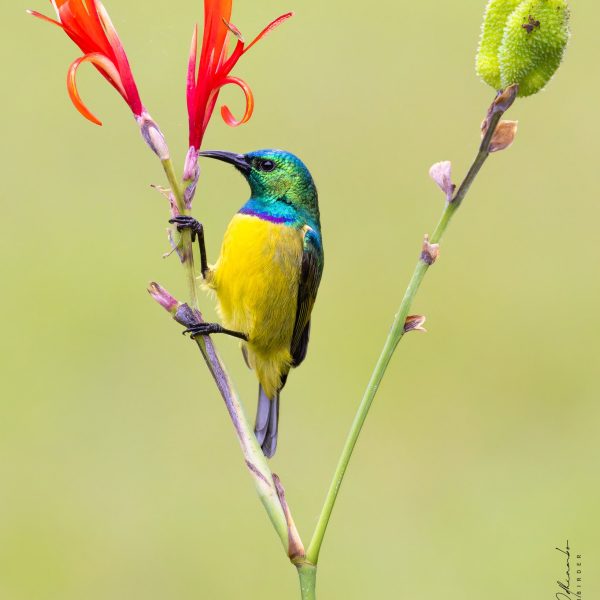
A Collared Sun bird. Photo Credit – @Kenyanbirder
Other birds of interest to look out for include Chapin’s Flycatcher, Common Buzzard, African Open-billed Stork, Chubb’s Cisticola, African Green Pigeon, Yellow-billed Duck, Rock Martin, Pale-bellied Forest Flycatcher, Turner’s Eremomela, Laughing Dove, White-headed Buffalo Weaver, Wolly-necked Stork, and Black-headed Gonolek. After a rewarding day of birding we transfer to Kisumu for overnight.
Meal Plan: Breakfast, Lunch and Dinner
Day 9: Birding to Lake Baringo
Today we transfer to Lake Baringo, an Important Bird Area (IBA) with an abundance of bird life located north of Nakuru town. The shallow fresh water lake is a bird watcher’s paradise and about 500 species of birds have been recorded here. Today we bird along the way, by the ponds and the fields. Birds of interest today will include the White-crested Turaco, Jackson’s Widowbird, Lesser Moorhen, Boran Cisticola, Little Rock-Thrush, White-billed Buffalo-weaver, Black-throated Barbet and Northern Brownbul.
Meal Plan: Breakfast, Lunch and Dinner
Journey time: 4.5 hours
Accommodation Options
Mid-range – Tumbili Cliff Lodge
Day 10: Birding at Lake Baringo
After an early breakfast at the lodge, we head out for birding around Lake Baringo. While at Lake Baringo one can expect to see lots of water birds as well as some of the Somali-Masai biome species. We will explore the entire area, go on a boat ride to look out for water species and papyrus endemics as well as explore the nearby thickets.
Birds to look out for include Northern Masked Weaver, Reed Cormorant, Pied Kingfisher, Hamerkop, Lesser Masked Weaver, Cattle Egrets, African Fish Eagle, Common Sandpiper, Goliath Heron, Speckled Pigeon, Little Egret, Giant Kingfisher, Ruppell’s Long-tailed Starling, African Darter, Namaqua Dove, Striated Heron,Hemprich’s Hornbill, Blacksmith Lapwing, Long-tailed Paradise, White-bellied Go-away bird, D’Arnaud’s Barbet, Common Waxbill, Northern Red Bishop, Chin-spot Batis, Red-cheeked Cordon-bleu, Bronze Sun bird, Yellow-fronted Canary, Jackson’s Hornbill etc. After a full day of birding we return to the lodge for dinner and overnight.
Meal Plan: Breakfast, Lunch and Dinner
Day 11: Transfer to Samburu National Reserve
Today we transfer to Samburu National Reserve after having breakfast at the lodge. The day will be majorly spent on the road but we shall use our time to bird along the way with stop overs when we see something interesting. Samburu National Reserve is located in Northern Kenya and over 380 species have been recorded at the reserve. The reserve is situated on the banks of Ewaso Ng’iro River in Kenya and located in Samburu County, on the other side of you find the Buffalo Springs National Reserve. Along the way we look out for the Jackson’s widow bird, on arrival we shall do some evening birding where we look out for the Black-bellied Sun bird, Somali Ostrich, Verreaux’s Eagle, Yellow-billed Oxpecker, and African Fish Eagle among others. You will then retire to the lodge for dinner and much needed rest.
Meal Plan: Breakfast, Lunch and Dinner
Journey time: 6.5 hours
Accommodation Options
Luxury – Sasaab Samburu
Mid-range – Ashnil Samburu Camp
Day 12: Birding Buffalo Springs National Reserve
Today we set out early in the morning and spend the full day birding Buffalo Springs. The national reserve is in close proximity with Samburu National Reserve and is situated on the other side of the Northern Ewaso Ng’iro River, the reserve consists of gently rolling plains of volcanic origin. Birds we look out for today include Scissor-tailed Kite, Bare-eyed Thrush, Ashy Cisticola, Red-eyed dove, Abyssinian Ground Hornbills, Pink-breasted Lark, Egyptian Vulture, Black Kori Bustard, Speckled Pigeon, Pygmy Batis, White-bellied Bustard, Golden Palm Weaver, Black-faced Sandgrouse, Black-capped social weaver, Martial Eagle, Black-bellied Sun bird, Chestnut weaver, Palm-nut Vulture, Secretary Bird, Golden pipit, Lanner Falcon, Greater Kestrel,Yellow-vented eromomela, Mariqua sun bird, Vulturine guinea fowl, D’Arnaud’s barbet, Fischer’s starling and Nothern brownbul among others.
Meal Plan: Breakfast, Lunch and Dinner
Day 13: Birding Samburu National Reserve
Today we continue our birding safari as we extensively bird Samburu National Reserve. You can expect to look out for savanna species, mid-elevation species, riverine forest species and endemic arid specials. Birds of interest today include Vulturine Guineafowl, Somali Ostrich, Hunter’s Sun bird, Yellow-necked Francolin, Speckled Pigeon, Kori Bustard, Black-bellied Bustard, Bare-faced Go-away bird, Red-chested Cuckoo, Spotted Thick-knee, Black-winged Stilt, Spur-winged Lapwing, Crowned Lapwing, Yellow-billed Stork, Long-tailed Cormorant, Goliath Heron, Hadada Ibis, Black-crowned Night heron, Black-winged kite, African Harrier-Hawk, African Fish Eagle, Speckled Mousebird, Narina Trogon, White-headed Mousebird, Green Wood Hoopoe, Northern Red-billed Hornbill, Little Bee-eater, White throated Bee-eater, Black-throated Barbet, Lesser Honeyguide, Pygymy Batis and African pied wagtail.
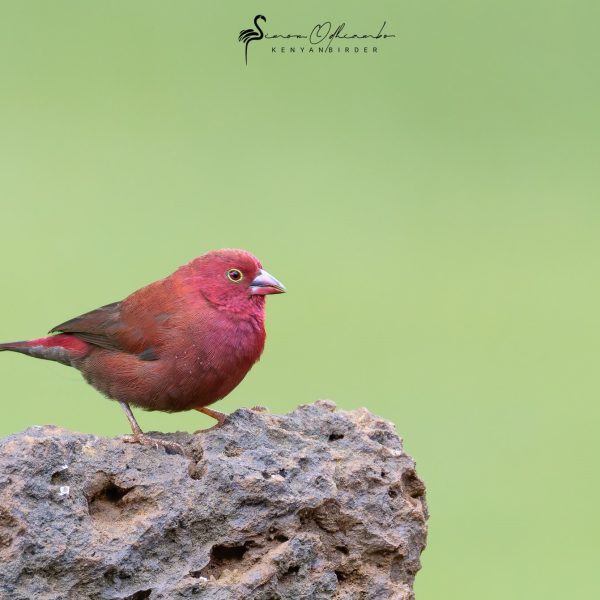
Red-billed Firefinch. Photo Credit-@Kenyanbirder
Other birds to look out for in Samburu include Verreaux’s Eagle, Grey-headed Kingfisher, Palm-nut Vulture, Tawny Eagle, Yellow-necked Spurfowl, Lilac-breasted Roller, Secretary Bird, Northern Red-billed Hornbill, Marabou Stork, Yellow-billed Hornbill, Bateleur, African Darter, Great Egret, Martial Eagle, Yellow-billed Oxpecker, White-headed Vulture, Donaldson Smith’s Sparrow weaver, Shining Sunbird, Bristle-crowned Starling, Crested Francolin and Helmeted Guineafowl among others. After a rewarding day of birding we head to the lodge for dinner.
Meal Plan: Breakfast, Lunch and Dinner
Day 14: Transfer to Aberdare National Park
Today we depart Samburu National Reserve for Aberdare National Park. Aberdare National Park is rich in bio diversity and an important water source for Kenya as four of the country’s seven largest rivers originate from the park. The Aberdares are a water catchment for the Tana River System, Lake Naivasha and the northern Ewaso Nyiro River. The habitat types in Aberdare national park harbour a variety of bird species and about 290 species of birds have been recorded at the park. This makes the national park a birding hot spot with chances of sighting montane specials, forest specials and mid to high elevation bird species. The most sought after bird in the park is the Aberdare Cisticola which is an endangered species and endemic to Kenya. We will bird along the way and also do a game drive in the park on arrival as we look out for birds and wildlife.
Meal Plan: Breakfast, Lunch and Dinner
Journey time: 4 hours
Accommodation Options
Luxury – The Ark Lodge
Mid-range – The Aberdare Country Club
Day 15: Birding Aberdare National Park
Today we set out to spend the full day birding Aberdare National Park. We will bird the southern slope grasslands, woody forest, scrub land and the forest near Nyeri.
About 290 species of birds have been recorded at the park and we look out for birds that include Aberdare Cisticola, Jackson’s Spurfowl, Africa Cuckoo-hawk, Mountain Buzzard, Hartlaub’s Turaco, Scarlet-tufted Sun bird, Tacazze Sun bird, Olive Ibis, Ayre’s Hawk-eagle, Crowned Eagle, Striped flufftail, Cape Eagle-owl, African Fish eagle, Sparrow Hawk, African Goshawk, Abyssinian Crimsonwing, African Paradise Flycatcher, Moustached green Tinker bird, Sharpe’s Longclaw, White-headed Wood-hoopoe, Silvery-cheeked Hornbill, Tambourine dove, Cinnamon chested Bee-eater, African yellow Warbler, Bar-tailed Trogon, Doherty’s Bush-shrike, Golden-winged Sun bird, Jackson’s Francolin, Moorland Francolin, Montane White-eye, and Hunter’s Cisticola among others. We will stop in the middle of the day and have our packed lunch then continue birding.
Meal Plan: Breakfast, Lunch and Dinner
Day 16: Birding to Castle Forest Lodge – Mount Kenya
After breakfast we head to Castle Forest Lodge, the lodge is situated next to a lush forest with stunning views of Mount Kenya and a waterfall that is within walking distance. Castle forest is a birding paradise and we will spend time exploring the different trails of the forest as we also bird on the slopes of Mount Kenya.
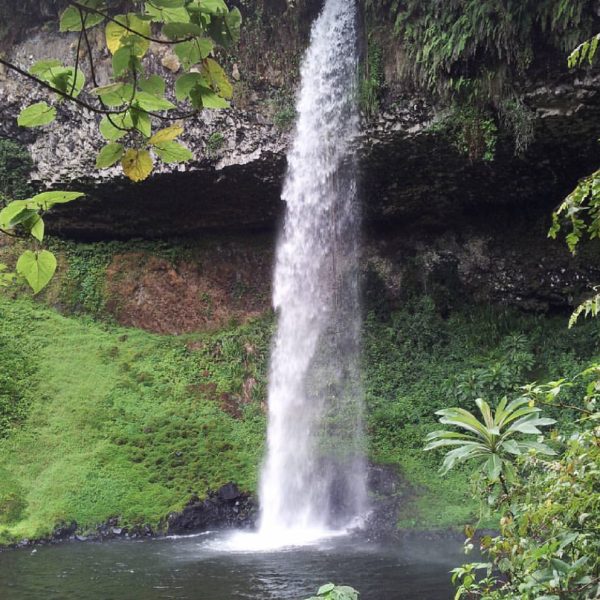
Mount Kenya is situated east of the Rift Valley, the mountain slopes consist of forest, bamboo, moorland and srub hence are great habitats for birds. Birds to look out for include the Kandt’s Waxbill, Barred Long-tailed Cuckoo, Lesser Kestrel, Long-tailed Widowbird, Olive Ibis, Ayre’s Hawk Eagle, Scarlet-tufted Sunbird, Cinnamon-chested Bee eaters, African Crowned Eagle, Mountain Yellow Warbler, Ruppell’s Robin-chat, Hartlaub’s Turaco, Silvery-cheeked Hornbill, African Emerald Cuckoo, Mountain Wagtail and Moustached Green Tinkerbird among others. We retire to the lodge later in the day for dinner and overnight.
Meal Plan: Breakfast, Lunch and Dinner
Mid-range – Castle Forest Lodge
Day 17: Birding Mount Kenya
Today we continue with birding Mount Kenya, Mount Kenya has a rich montane bird fauna. Birds to look out for today include Abyssinian Crimson-wing, Yellow-crowned canary, White-starred robin, Tacazze Sun bird, Crowned Hornbill, Jackson’s widow bird, Scarlet-tufted sun bird, Kenrick’s starling, Sparrow hawk, White-tailed crested flycatcher, Sharpe’s Long claw, Red-eyed dove, Grey-crowned crane, Hamerkop, Great Egret, Hadada Ibis, African sacred ibis, Speckled mouse bird, Mountain gray woodpecker, Olive Sun bird, Brown-backed woodpecker, African Paradise flycatcher, Pied crow, African thrush, Scarlet-chested sun bird, Bronze sun bird, Malachite sun bird, Village weaver, Yellow bishop, Brown-capped weaver, African pied wagtail and African Pipit among others. After a rewarding day of birding we return to the lodge for dinner.
Meal Plan: Breakfast, Lunch and Dinner
Day 18: Transfer to Nairobi
Today you will have a hearty breakfast at Castle Forest lodge after which we begin the journey to Nairobi as we bird along the way. On arrival you check into your hotel in Nairobi, relax and take some much needed rest at the hotel after a long rewarding safari. The rest of the day will be spent at leisure and you can choose to make use of the hotel amenities.
Meal Plan: Breakfast, Lunch and Dinner
Journey time: 4 hours
Accommodation Options
Luxury – Kwetu Nairobi, Curio Collection by Hilton
Mid-range – The Social House, Nairobi
Day 19: Departure
Today marks the end of your 19 Day Kenya Birding Safari as your driver guide will transfer you to the airport for your flight back home.
Meal Plan: Breakfast
This Safari Includes
- Birding Fees at the national parks and birding sites
- Park entrances
- 4WD Safari Car with popup roof
- Fuel
- English Speaking Professional Birding Guide
- Full Board accommodation as mentioned in the itinerary
- Drinking water in the car
This Safari does NOT include
- Optional activities
- International flights
- Porter fees
- Tips
- Insurance and visa charges
- Other personal expenses while on safari

